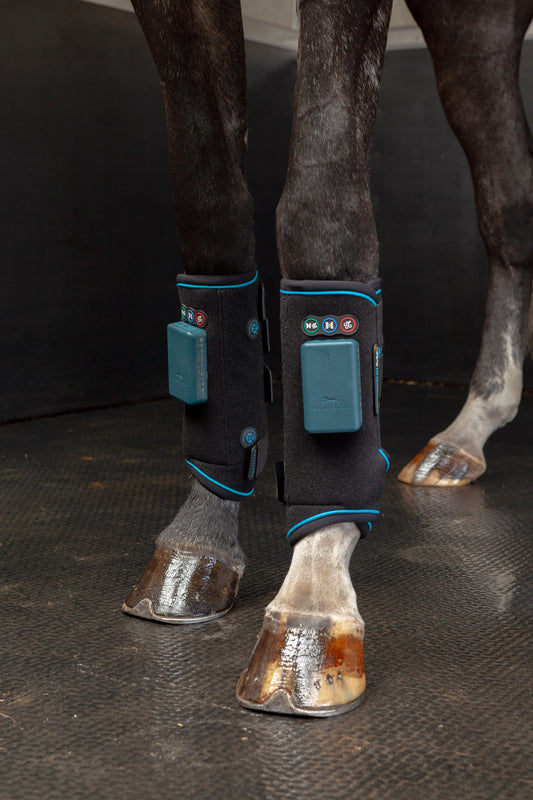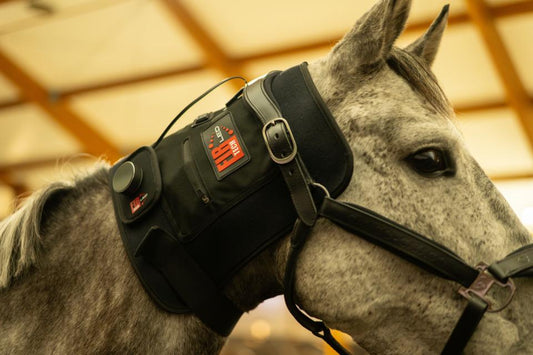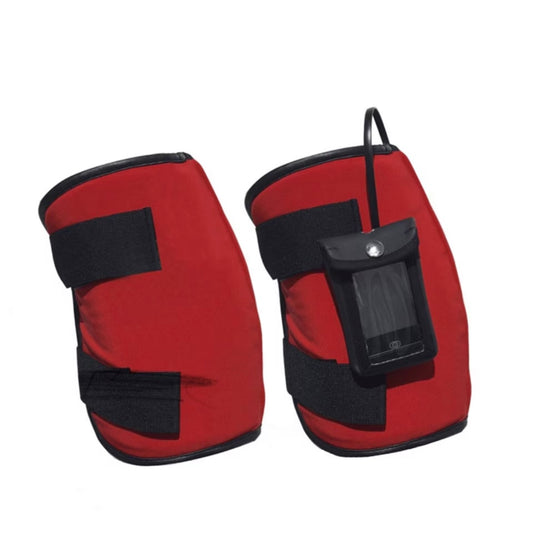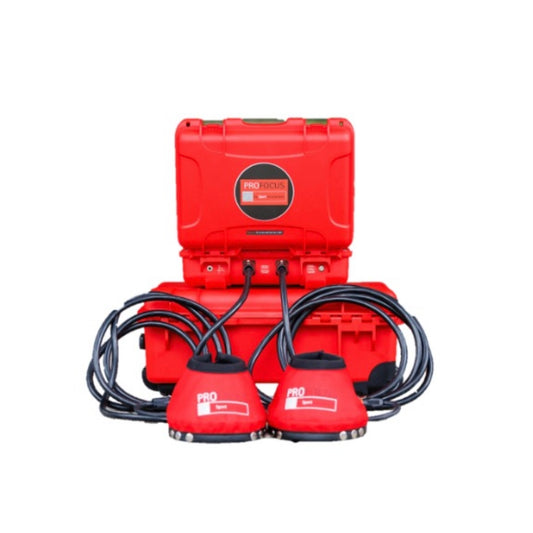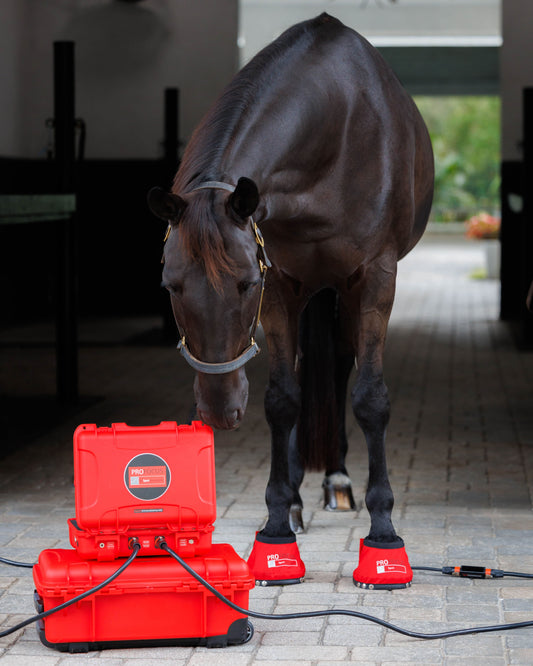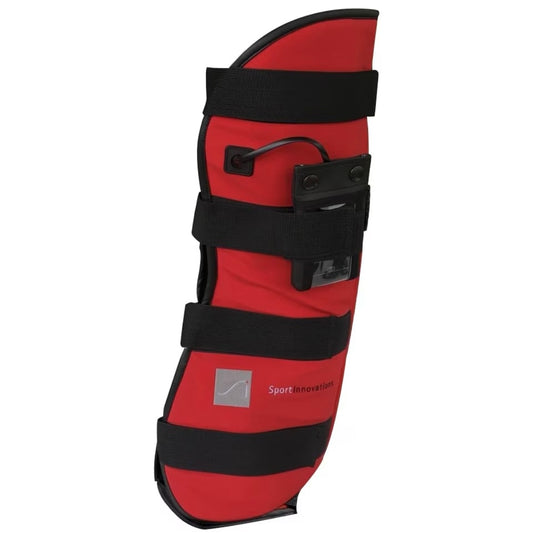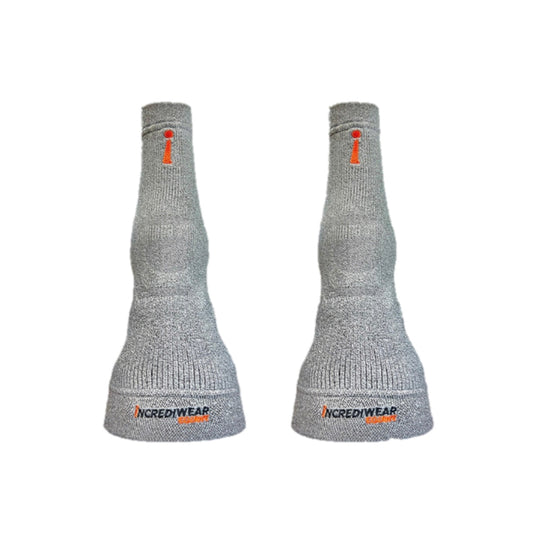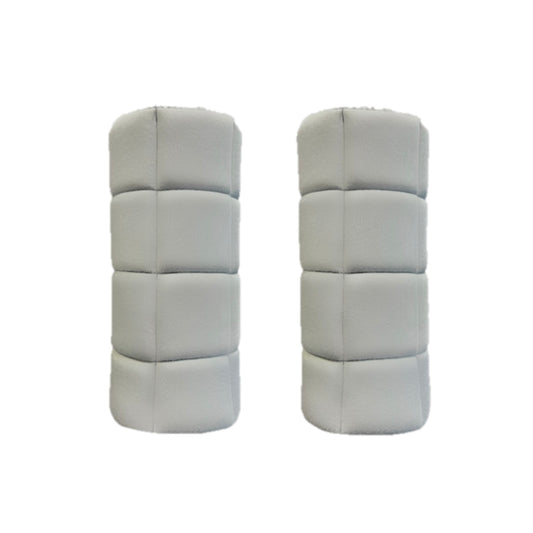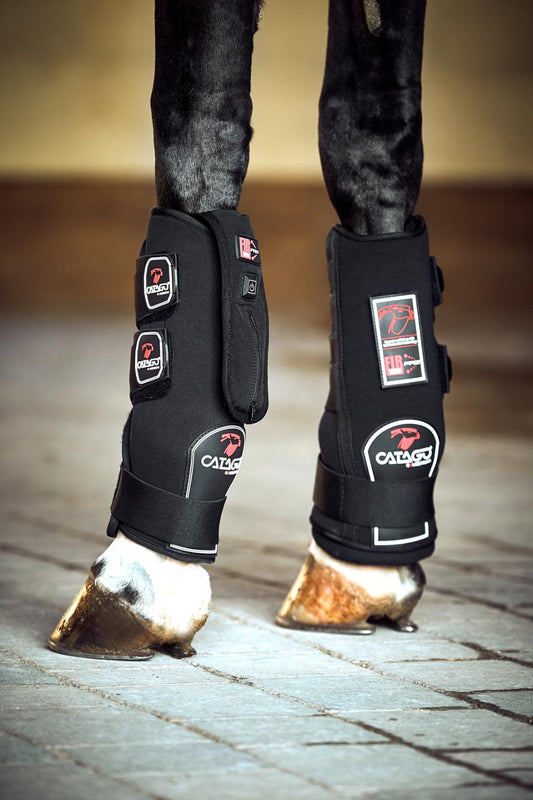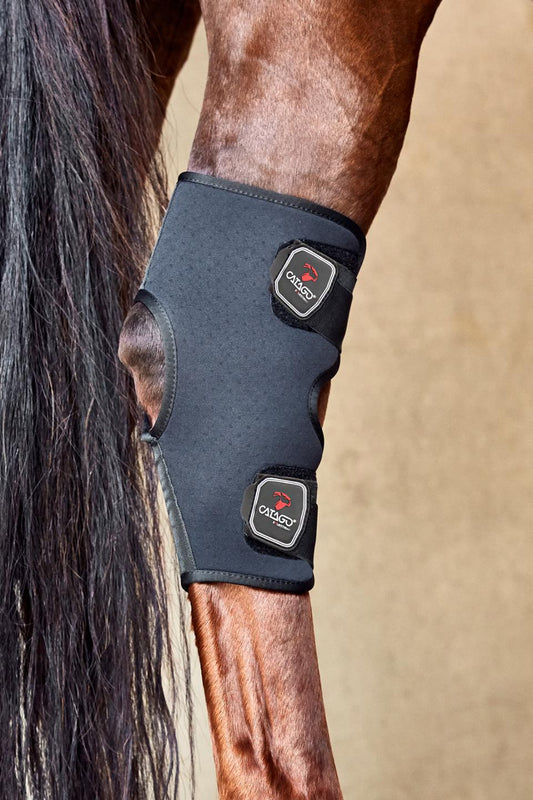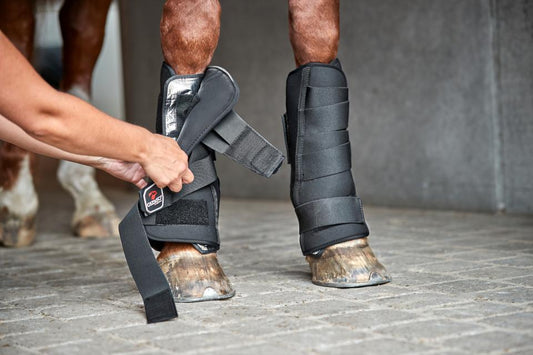Ligament Injuries
Suspensory Ligament Injury
The suspensory ligament (SL) plays a vital role in the equine limb by supporting the fetlock joint and absorbing shock during movement. Injuries to the SL are a common cause of lameness, particularly in horses involved in high-impact sports. Early recognition, appropriate management, and advanced therapies are essential for achieving the best outcomes.
General Information
- Anatomy and Function:
The suspensory ligament is a dense, fibrous structure that originates from the proximal region of the cannon and splint bones, branches around the fetlock, and attaches to the sesamoid bones. It prevents overextension of the fetlock and is critical for locomotion and weight-bearing. - Types of Injuries:
How to Recognize a Suspensory Ligament Injury
Clinical Signs:
- Lameness: Often intermittent, worsens with exercise.
- Localized Swelling: Subtle but present in the affected ligament area.
- Pain on Palpation: Particularly noticeable in the branches or proximal suspensory region.
- Dropped Fetlock Appearance: Seen in severe or chronic cases, especially with complete ligament failure.
- Performance Issues: Reduced willingness to jump, turn, or engage hindlimbs.
Diagnosis:
Advanced imaging, such as ultrasound or MRI, is required to determine the extent and precise location of the damage.
Causes of Suspensory Ligament Injury
Common Contributing Factors:
- Overuse or Overloading: Frequent in horses involved in jumping, dressage, and racing.
- Poor Conformation: Conformational defects, such as long, sloping pasterns, increase ligament stress.
- Degeneration: Age-related changes that weaken ligament fibers.
- Improper Hoof Balance: Uneven trimming or shoeing disrupts biomechanics, increasing strain.
- Trauma: Acute injuries caused by missteps, falls, or sudden directional changes.
- Poor Ground Conditions: Uneven or overly hard footing exacerbates strain on the ligament.
How to Prevent Suspensory Ligament Injuries
Preventative Strategies:
- Gradual Fitness Training: Build strength and elasticity through progressive conditioning.
- Balanced Hoof Care: Ensure regular trimming and shoeing for proper limb alignment.
- Monitor Workload: Avoid overtraining and schedule rest periods.
- Supportive Bandages: Use during high-intensity activities to provide additional support.
- Surface Management: Train and compete on well-maintained footing to minimize impact-related injuries.
- Early Detection of Stress: Conduct routine veterinary evaluations and observe for subtle lameness signs.
What to Do If Your Horse Has a Suspensory Ligament Injury
Immediate Steps:
- Stop All Activity: Cease exercise immediately to prevent further damage.
- Cold Therapy: Apply cold hosing or ice packs for 20-30 minutes every 4-6 hours during the first 48 hours to reduce inflammation.
- Rest and Restriction: Enforce strict box rest during the initial healing phase.
- Veterinary Assessment: Use ultrasound or MRI to determine the injury's severity and location.
Management During Healing:
- Controlled Exercise Program: Gradually reintroduce activity under veterinary guidance after the acute phase.
- Anti-Inflammatory Medications: NSAIDs may be prescribed to manage pain and inflammation.
- Shockwave Therapy: Helps stimulate healing in some cases, particularly in the proximal suspensory region.
Therapies to Aid Recovery
Advanced therapies can enhance healing, reduce scar tissue formation, and improve ligament repair quality:
- Cooling Therapy:
- PEMF Therapy (Pulsed Electromagnetic Field):
- LED Therapy:
- Infrared Therapy:
- NMES Therapy (Neuromuscular Electrical Stimulation):
- Vibration Therapy:
Conclusion
Suspensory ligament injuries require a comprehensive management approach, including rest, controlled exercise, and advanced therapeutic modalities. Early detection and proper care, combined with cutting-edge treatments, enable many horses to recover fully and return to their previous activity levels.
Preventative measures, such as gradual fitness training and proper hoof care, are essential in minimizing the risk of future injuries. If your horse has a suspensory ligament injury, consult your veterinarian promptly and consider advanced therapeutic products to support their recovery journey.
Annular Ligament Injury
The annular ligament is a key component of the equine limb, crucial for maintaining the function of the flexor tendon system that supports the hoof. Located at the fetlock joint, it helps stabilize the flexor tendons during movement. Injuries to this ligament can severely impact a horse’s mobility and performance, particularly in high-level competition or working horses.
General Information
- Structure and Function:
The annular ligament surrounds the flexor tendons at the fetlock joint, securing the deep digital flexor tendon (DDFT) and superficial digital flexor tendon (SDFT). It prevents excessive outward bowing of the tendons and comprises two parts: - Common Issues:
Injuries to the ligament can lead to bowed tendons, lameness, and chronic complications if untreated, potentially causing permanent tendon sheath damage. These injuries are frequent in horses participating in high-impact activities such as jumping, racing, and dressage.
How to Recognize an Annular Ligament Injury
Clinical Signs:
- Lameness: Mild to moderate at first, worsening with exercise. May affect one or both forelimbs.
- Swelling: Visible around the fetlock, often on the medial or lateral aspect.
- Heat: Warmth in the affected area due to inflammation or fluid accumulation.
- Pain on Palpation: Tenderness when the ligament or surrounding tendon sheaths are pressed.
- Bowed Tendon Appearance: A visible bow or bulge in the tendon due to dislocation or bowing caused by ligament damage.
- Restricted Motion: Difficulty flexing or extending the limb fully.
Diagnosis:
Ultrasound imaging is commonly used to assess injury severity. MRI or X-rays may also be recommended to rule out concurrent injuries.
Causes of Annular Ligament Injury
Contributing Factors:
- Overuse or Repetitive Strain: Common in high-impact activities, leading to inflammation or rupture.
- Conformational Abnormalities: Faulty limb structure can predispose horses to ligament stress.
- Trauma or Sudden Impact: Acute injuries from falls, missteps, or abrupt changes in direction.
- Improper Training or Overloading: Excessive training or inadequate rest increases injury risk.
- Lack of Proper Warm-Up: Insufficient warm-up time before activity strains the ligament.
- Inadequate Footing: Hard or uneven training surfaces increase ligament stress.
How to Prevent Annular Ligament Injury
Preventative Strategies:
- Gradual Training Progression: Build strength and flexibility through structured, gradual increases in exercise intensity.
- Proper Warm-Up and Cool-Down: Helps prepare ligaments for activity and supports post-exercise recovery.
- Conditioning: Regular exercises to enhance tendon and ligament strength and flexibility.
- Hoof Care and Conformation: Regular trimming and shoeing ensure proper balance and alignment, reducing stress on the ligament.
- Rest and Recovery: Adequate downtime prevents overuse injuries.
- Footing Management: Train and compete on soft, even surfaces to reduce limb impact.
What to Do If Your Horse Has an Annular Ligament Injury
Immediate Steps:
- Cease Activity: Stop exercise immediately to prevent further damage.
- Cold Therapy: Apply cold hosing or ice packs for 20-30 minutes every 4-6 hours during the first 48 hours to reduce swelling and inflammation.
- Veterinary Assessment: Schedule an examination to confirm the diagnosis. Imaging (ultrasound, MRI) may be required to assess severity.
- Anti-Inflammatory Medications: NSAIDs may be prescribed to manage pain and inflammation.
- Rest: Follow veterinary recommendations for box rest and gradual return to exercise.
- Bandaging: Supportive bandaging or splints may be recommended to stabilize the area.
- Monitor Progress: Regular follow-ups ensure proper healing and detect complications early.
Therapies to Aid Recovery
Advanced therapies can accelerate healing, reduce inflammation, and minimize scar tissue formation:
- Cooling Therapy:
- PEMF Therapy (Pulsed Electromagnetic Field):
- LED Therapy:
- Infrared Therapy:
- NMES Therapy (Neuromuscular Electrical Stimulation):
- Vibration Therapy:
Conclusion
Annular ligament injuries can significantly impact a horse’s performance and mobility. Early detection, combined with appropriate rest and advanced therapeutic interventions, can lead to successful recovery. Preventative measures, such as proper training, conditioning, and hoof care, are essential to reduce the risk of these injuries.
For optimal results, consult a veterinarian promptly if you suspect an injury and consider advanced therapies to aid recovery and restore your horse’s performance.
Collateral Ligament Damage
Collateral ligaments play a crucial role in maintaining joint stability in a horse's limb. Damage to these ligaments can lead to lameness and long-term performance issues, particularly for sports horses. Early identification and treatment are essential for a successful recovery.
General Information
- Location and Function:
Collateral ligaments are located on the sides of major joints, such as the fetlock, knees, and tarsus (hock). They provide lateral and medial support, preventing excessive joint movement and contributing to overall stability. These ligaments are crucial for maintaining proper limb alignment and function, especially during high-stress activities like jumping, racing, or dressage. - Types of Injuries:
Collateral ligament injuries can range from mild sprains to complete tears. These injuries may affect one or both limbs, and their management depends on the severity of the damage.
How to Recognize Collateral Ligament Damage
Common Clinical Signs:
- Lameness: Typically mild to moderate, worsening with exercise.
- Swelling: Notable around the joint, especially on the medial or lateral aspect.
- Pain on Palpation: Tenderness when pressure is applied to the affected ligament.
- Joint Instability: In severe cases, the joint may feel unstable or exhibit abnormal side-to-side movement.
- Reduced Range of Motion: Limited flexion or extension of the joint due to pain or instability.
- Heat: Inflammation within 24-48 hours after injury.
- Change in Gait: The horse may alter its gait to avoid painful movement or shift weight off the affected limb.
Diagnosis:
A veterinary examination, often supplemented by ultrasound or X-rays, is crucial to confirm the injury and assess its severity.
Causes of Collateral Ligament Damage
Common Contributing Factors:
- Trauma or Direct Impact: Sudden impact or missteps during training or competition.
- Overuse or Repetitive Stress: Excessive strain from sports like jumping or racing can lead to ligament degeneration.
- Conformational Issues: Horses with abnormal limb conformation or joint alignment are more prone to injury.
- Uneven Ground or Slippery Surfaces: Poorly maintained or uneven surfaces increase the risk of ligament strain.
- Fatigue or Muscle Weakness: Weakness in muscles surrounding the joint increases the load on the ligaments.
- Previous Joint Injuries: A history of joint instability or other injuries increases the risk of collateral ligament damage.
How to Prevent Collateral Ligament Damage
Preventative Measures:
- Progressive Conditioning: Gradually increase exercise intensity to avoid overloading joints and ligaments.
- Proper Farriery: Regular hoof care ensures correct limb alignment, reducing strain on the joints.
- Balanced Training Program: Include rest periods and vary exercises to prevent repetitive strain on the same joints.
- Surface Management: Use well-maintained, even surfaces for training and competition to minimize joint stress.
- Joint Supplements: Provide supplements like glucosamine and chondroitin sulfate to support ligament and joint health.
- Warm-Up and Cool-Down: Implement proper warm-up and cool-down routines to prepare ligaments for activity and aid recovery.
- Weight Management: Maintain a healthy weight to reduce strain on joints and ligaments.
What to Do If Your Horse Has Collateral Ligament Damage
Immediate Action:
- Immediate Rest: Cease all exercise immediately and limit movement to avoid further injury.
- Cold Therapy: Apply ice packs or cold therapy for 20-30 minutes every 2-4 hours during the first 48 hours to reduce swelling and inflammation.
- Veterinary Evaluation: Contact your veterinarian for an assessment, including imaging (ultrasound or X-rays) to confirm the injury and rule out other causes.
- Box Rest: Restrict the horse to box rest to avoid movement that could worsen the injury.
- Medication: NSAIDs may be prescribed to manage pain and inflammation.
- Bandaging: In some cases, supportive bandaging may be suggested to stabilize the joint.
- Monitor Progress: Follow-up appointments with the veterinarian ensure proper recovery and detect any complications.
Therapies to Aid Recovery
Advanced Therapeutic Options:
- Cooling Therapy:
- PEMF Therapy (Pulsed Electromagnetic Field):
- LED Therapy:
- Infrared Therapy:
- NMES Therapy (Neuromuscular Electrical Stimulation):
- Vibration Therapy:
Conclusion
Collateral ligament damage requires immediate attention and proper care to prevent further complications. With early intervention, appropriate rest, and the use of advanced therapeutic treatments, horses can often make a full recovery and return to their previous level of performance. Preventative measures such as proper conditioning, joint care, and careful management can significantly reduce the risk of these injuries.
If your horse suffers from collateral ligament damage, consult your veterinarian for an accurate diagnosis and explore therapeutic options to optimize recovery.


